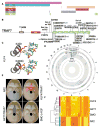Genomic analysis of non-NF2 meningiomas reveals mutations in TRAF7, KLF4, AKT1, and SMO
- PMID: 23348505
- PMCID: PMC4808587
- DOI: 10.1126/science.1233009
Genomic analysis of non-NF2 meningiomas reveals mutations in TRAF7, KLF4, AKT1, and SMO
Abstract
We report genomic analysis of 300 meningiomas, the most common primary brain tumors, leading to the discovery of mutations in TRAF7, a proapoptotic E3 ubiquitin ligase, in nearly one-fourth of all meningiomas. Mutations in TRAF7 commonly occurred with a recurrent mutation (K409Q) in KLF4, a transcription factor known for its role in inducing pluripotency, or with AKT1(E17K), a mutation known to activate the PI3K pathway. SMO mutations, which activate Hedgehog signaling, were identified in ~5% of non-NF2 mutant meningiomas. These non-NF2 meningiomas were clinically distinctive-nearly always benign, with chromosomal stability, and originating from the medial skull base. In contrast, meningiomas with mutant NF2 and/or chromosome 22 loss were more likely to be atypical, showing genomic instability, and localizing to the cerebral and cerebellar hemispheres. Collectively, these findings identify distinct meningioma subtypes, suggesting avenues for targeted therapeutics.
Figures


Comment in
-
SMO and AKT1 mutations occur in non-NF2 meningiomas.Cancer Discov. 2013 Mar;3(3):OF13. doi: 10.1158/2159-8290.CD-RW2013-028. Epub 2013 Feb 7. Cancer Discov. 2013. PMID: 23475883
-
Identification of novel therapeutic targets through genomic analysis of meningiomas.Neurosurgery. 2013 Aug;73(2):N22-4. doi: 10.1227/01.neu.0000432626.41718.68. Neurosurgery. 2013. PMID: 23867274 No abstract available.
References
-
- Riemenschneider MJ, Perry A, Reifenberger G. Lancet Neurology. 2006;5:1045. - PubMed
-
-
Materials and methods are available as supporting material on Science online.
-
Publication types
MeSH terms
Substances
Grants and funding
LinkOut - more resources
Full Text Sources
Other Literature Sources
Medical
Molecular Biology Databases
Miscellaneous

